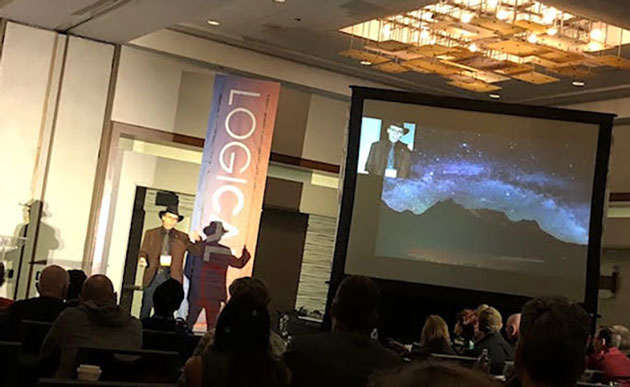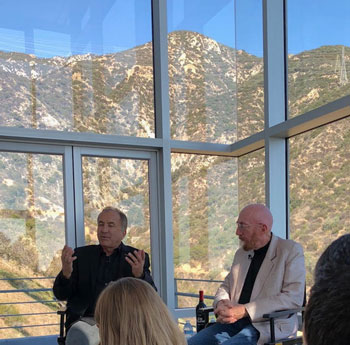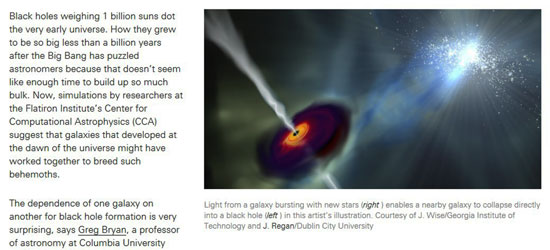Well, the launch of the Falcon 9 rocket from Vandenberg has been delayed again so we didn't get out for any image collection. I can't try for the now scheduled launch this Wednesday either because I will be on the dreaded 405 Fwy driving to the Dark Matter conference at UCLA at that time. Maybe you can grab a photo, but if you are not on the signup list to get last minute notices of launch delays, the following screen shot shows what the typical announcement looks like, and you might want to know if it gets delayed again:
 |
| Falcon 9 launch from Vandenberg delayed |
So, we didn't get out and do any observing of the launch and in addition the night clouds have been pretty heavy preventing other nighttime observing during the week, but we did get to attend some public lectures. The first lecture was at the LogicaLA 2018 conference where Lawrence Krauss was the keynote speaker. I've got most of Krauss' books and always look forward to what he has to say about cosmology and he always keeps things interesting. I have misplaced my notes about his talk and can't recall the major points that I wanted to repeat here. I do remember that he started his talk by asking how many people in the audience were from LA and of course most all hands went up. He then joked that he would have to start his talk about cosmology by first talking about stars and what stars were! I know in my own case, unless I go out to a dark sky site, I have to strain and squint and dodge about in order just to see the North Star, Polaris, which comes in at magnitude 2.0. I can spot Orion and a few other bright stars, but we are quite limited in what stars we can see.
 |
| Lawrence Krauss speaks at LogicaLA 2018 conference |
Next up was the opportunity to hear Kip Thorne speak as part of an interview conducted at the Skeptics Society Science Salon. The Science Salon is conducted high in the hills in Altadena and usually includes book signing and wine and hors d'oeuvres in a small limited attendance environment. Just compare for instance how close we could get to Kip in the Science Salon and how "close" we were at the LogicaLA lecture.
 |
| Michael Shermer introduces Kip Thorne at the Science Salon |
Privately, I debated whether to bring my 14 pounds of books, which is what just two of Kip's textbooks weighs in at, with me and ask him to sign them, but at they end, I just decided to leave them at the observatory and just enjoy the soiree without being weighed down.
Kip talked about how he first got involved in physics and how an early astronomy lecture at 8 years old and then reading at 13 years, George Gamow's book, "One, Two, Three .. Infinity", which I also still have my own copy of, which I also read at about the same age. Hey, with that same great beginning how come he ends up winning the Nobel and I just barely am still a physicist wannabe? Anyway, he said he liked to work in areas of physics that were not too crowded and picked gravitational waves for that reason. In fact, he was discouraged by one of his advisors not to go into that field because nothing would come of it. Well, a lot did come from it! Now he says he is in sort of a second career and after completing his work on the movie, Interstellar, he is working on a new movie, about which he is not allowed to say anything.
Anyway, I really enjoyed his discussion and I made a note of three items to check up on. He says that his favorite explanation of why gravity attracts objects, like we are attracted to the Earth, is because that attraction is just enough to account for the time distortion due to the mass of the Earth. Wow, that is one explanation I had not heard before. Of course, it is the case that the time distortion, the fact that clocks run slower on the surface of the Earth than they do when at high above the Earth, and this same distortion affects how we just naturally want to move, which is towards the center of the Earth.
Then he described how the discovery of gravitational waves, which is ushering in this new age of astronomy, enables the direct estimate of distance to the source. Now, I couldn't quite remember how the distance is determined, other than the intensity of the gravitational wave falls off as one over the distance, which if the masses of the merging black holes or whatever can be determined, then the intensity of the waves at the source can be determined and then from the received intensity here a LIGO, we can determine the distance. I'm going to have to look into the details of this a little deeper, because being able to determine the distance is a big improvement. Optical astronomers can easily measure the red shift to the source objects, but they have a hard time determining the distance optically.
Thirdly, there was a remote online question from Facebook, or somewhere, regarding how much of a merger's mass can be turned into gravitational waves. We know that the sources of energy given off by various astrophysical objects are based on the underlying physics. For example, stars shine because of fusion, which converts about 0.7% of the mass into energy. Accretion of matter falling into neutron stars and black holes can release a more widely unknown percentage of energy, ranging from 15% to 31% to 50%, but nonetheless much higher efficiency than is possible with just fusion. But, back to the original question about how much of the merger can go out as gravitational waves, unfortunately, I could not quite grab the answer. I asked Math Whiz Dave, who also attended the soiree and he wasn't sure of how Kip responded answer either. So, we agreed to set that problem aside for homework and see what the answer is. We know from just a few observed mergers, the amount of mass going into gravitational waves was only a couple of percent of the merging masses. Anybody out there know what is the maximum possible percentage of he merger mass that can be released as gravitational waves?
Finally, again, since the clouds kept getting in the way, during the week I watched a couple of the Discovery Channel's "How the Universe Works" episodes. I forget what the episode title was, but it discussed again this relationship between the size of the black hole at the center of most galaxies and how that size is correlated very well with the size of the galaxy itself. What is the cause of this correlation? It is kind of a chicken or the egg type of issue, but it seems that feedback from accretion of gas on the black hole and star formation feedback tend to work together to set the size of the black hole and the galaxy.
This is a really neat concept, so I searched a bit for some more information about how the black hole can end up being so large, often several million or billion times more massive than the Sun. It seems that a leading explanation relies on sort of a nearby helper galaxy, which triggers the collapse of a massive black hole in its partner galaxy. Check out this artists image showing how this might work.
 |
| It might take two galaxies to create a supermassive black hole (Source: www.simonsfoundation.org) |
Next time I hope to follow up on how giant molecular clouds of gas can collapse to form stars and solar systems and how they lose energy and cool off and angular momentum, which is necessary for collapse in the first place.
Until next time,
Resident Astronomer George
If you are interested in things astronomical or in astrophysics and cosmology
Check out this blog at www.palmiaobservatory.com

No comments:
Post a Comment